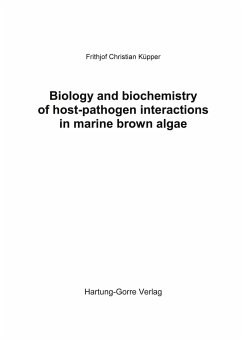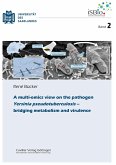Associations of marine algae with symbiotic or parasitic microorganisms are ubiquitous phenomena known for a long time. However, there is an almost complete lack of knowledge on details of such interactions. The intention of this study is to use the potentials of modern biological and biochemical techniques in order to analyze the reaction of brown algal hosts to the attack by pathogens and epibionts. A 3-year field study at different localities on the European Atlantic coast revealed that Pylaiella littoralis populations were subject to massive epidemics of the parasites Eurychasma dicksonii, Chytridium polysiphoniae and Anisolpidium rosenvingei. Laboratory cultures were used to investigate the association of Eurychasma and Chytridium with brown algal hosts from different taxonomic groups: Eurychasma has a much broader host range than Chytridium, comprising members of all brown algal orders investigated, and it tolerates a wider range of temperatures than the latter. Phylogenetic studies based upon 18 S rRNA genes revealed that Eurychasma dicksonii belongs to the Oomycota, branching at an ancestral position between terrestrial plant pathogens and free-living members of the marine heterotrophic picoplankton. Chytridium polysiphoniae, a fungus, appears more closely related to the genera Rhizophydium and Spizellomyces (Chytridiomycota) than to other known Chytridium species. Chytridium produces chitin, whilst Eurychasma does not. Early stages of Eurychasma infection have a rather modest effect on host physiology. The photosynthetic capacity is enhanced, suggesting a temporary stimulation of host metabolism for hypertrophic growth. Chytridium, in contrast, has an immediate detrimental effect on host photosynthesis, which breaks down once a cell is infected, leading to the rapid death of infected cells.
Hinweis: Dieser Artikel kann nur an eine deutsche Lieferadresse ausgeliefert werden.
Hinweis: Dieser Artikel kann nur an eine deutsche Lieferadresse ausgeliefert werden.







